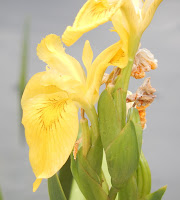By mid-May, looking at the statistics I'd been keeping here at Bean Hill, I predicted we were going to see a record-setting month. I really hoped I'd be proven wrong. I wasn't.
 |
| Water iris |
While no new daily record highs were set in our immediate area, overall this was the hottest May ever recorded for Central Ohio. Throughout the lower-48, it was the hottest May since the Dust Bowl year 1934. On May 30, it was a reasonable 84
⁰ here after five straight days of upper 80's and lower 90's--July and August temperatures--but that day 1,900 U.S. cities tied or set record highs. The United Kingdom experienced its hottest, driest May ever. NOAA reports that May 2018 was Earth's 4th-warmest May on record. But here's the really scary fact: Including this year, the Earth's four warmest Mays all happened in the last five years.
At Bean Hill, I recorded thirty days of above-normal highs, and 27 nights of above-normal lows. Twenty-three days had highs that were 5
⁰ or more above normal; sixteen of those days had highs that were 10-15
⁰ above normal. Sixteen nights had lows 12-27
⁰ above normal. The average day-time high for May 2018 was 81.5
⁰--a whopping 8.5
⁰ above the historic average. Historically, the month's average low temperature is 52
⁰, but this May's average low was 6
⁰ above that.
 |
Heirloom peonies.
These beauties are 61 years old!
|
On top of the heat, the month was very wet. We had 2" more rain than the May average of 3.88". Nearly the entire monthly average (3.47") fell over just four days in the last half of the month. Central Ohio is famous for its humidity, but this year the heat coupled with the abundance of rain gave the place a tropical feel. May is the month in which garden and yard maintenance begin in earnest, and once, more than 5 years ago when temperatures were "normal", it was a really pleasant time to be outside working. In the recent past, it's become a challenge to do any sustained garden work; the month of May has become not so merry.
 |
| Poppies |
Another thing that I've noticed the past five years is spring flowering plants--irises, peonies, fruit trees--aren't holding their blooms more than a very few days. I think this is related to the wild temperature fluctuations we've been experiencing in the winter months. Plants set buds as early as February that begin to mature, and then comes a freeze, then a warm-up, then another freeze. Last month, when abnormally frigid low temperatures occurred nightly for more than a week, a number of the peonies had already reached more than a foot in height and were topped with young leaves. Probably because of that battering, our peonies bloomed quite late, and then died within four days. Last year, after a too-warm February, the bearded iris grew too fast before the inevitable freeze hit-- not a single one bloomed.
This year, we lost all but two of a dozen lavender plants. I went to Baker's Acres today to try to find some replacements, but they were sold out. While there, I saw a bee gathering nectar from a coneflower, and I watched it a bit before I realized that in this vast perennial nursery, where everything was in flower, that was the only bee to be seen. It made me very sad.
I apologize for this grim blog. We seem to be surrounded by grim news now days, and it's very hard to not be sucked into the black hole of despair.
I hope the beauty of some nature photos can serve as a counter-weight.
 |
| Crabapple in bloom |







































 I discovered that Gardeners Supply has a great informational section called "Learn and Share", covering a variety of topics such as how to create a Backyard Habitat https://www.gardeners.com/how-to?folder=backyard-habitat-articles. I also discovered the online version of the Old Farmer's Almanac has great vegetable-growing advice that we hope will help improve our veggie garden yield https://www.almanac.com/gardening.
I discovered that Gardeners Supply has a great informational section called "Learn and Share", covering a variety of topics such as how to create a Backyard Habitat https://www.gardeners.com/how-to?folder=backyard-habitat-articles. I also discovered the online version of the Old Farmer's Almanac has great vegetable-growing advice that we hope will help improve our veggie garden yield https://www.almanac.com/gardening.